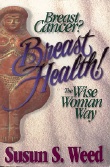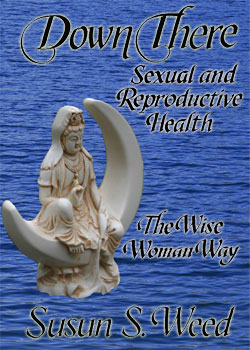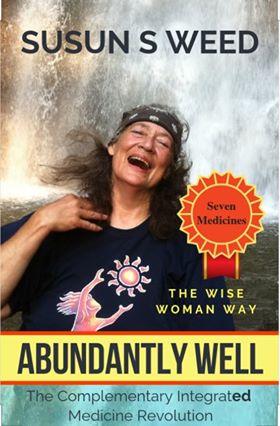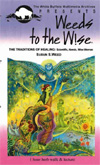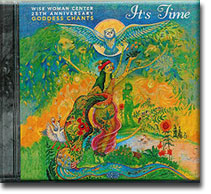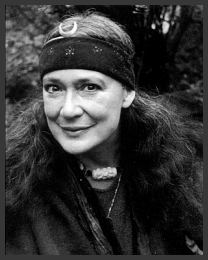Nutrition
Susun S. Weed
The biochemical and energetic nutrients which we digest, absorb, and metabolize from foodstuffs are the foundation of all cellular activity in the body, including growth, repair, reproduction, resistance to disease, and maintenance. Good nutrition is critically important to every form of life we know. Finding, growing, preparing, and storing food has been women's work and women's genius since time out of mind.
The Spirit of the Food
Nutrition begins with milk from mother's breast, from the breast of the Great Goddess. In earth-centered cultures, the harvesting and gathering of food is interwound with sacred threads, and the consumption of the food is a sacrament. This aspect of nutrition is invisible, unmeasurable, undiscussed, but of utmost importance to the health of the individual and the ecology.Healthy Diets
When food choices are limited, women eat whatever is available. As long as adequate carbohydrates, protein, fats, vitamins, and minerals are consumed and clean water is available, health is easily maintained.(1) Restricted diets (vegan, vegetarian, impoverished) generally fail to provide adequately for women, and the addition of milk products, eggs, or meat to these diets optimizes health. When the food supply is abundant and foods are highly refined, as is the case in most Western countries, food choices may adversely affect health. This is due in part to an innate (healthy) craving for sweet, salt, and fat (which are scarce in nature but commercially abundant, leading to overconsumption) and in part to the degradation of the foodstuffs themselves.Protein
After water, protein is the most plentiful substance in our bodies. Without protein we cannot create enzymes, antibodies, milk, menses, skin, hair, nails, muscle, brain, heart, or organs. We require twenty-two different amino acids (building blocks of protein), of which eight are considered essential nutrients. Animal foods contain all essential amino acids. No one food of vegetable origin contains them all, but combinations (such as corn and beans) do. Each and every amino acid must be present at once in the body, and in the correct proportions, for protein synthesis. If even one essential amino acid is low or missing, even temporarily, protein production slows or stops altogether.(2) Adult women can be healthy on low protein diets; however children, pregnant, lactating, and menopausal women require high levels of protein.Fats
Fat is the most concentrated source of energy in the diet. Found in vegetable seeds, beans, and nuts, fruits such as olives and avocados, and in all animal products, fat is vital to women's health. Unfortunately, many American women avoid fat. A recent study (1999) found 26 percent of women deficient in vitamin E due to low-fat diets.
Linoleic, linolenic, and arachidonic fats are the essential fatty acids, but all fats, especially cholesterol, are vital for the formation of sex hormones (especially postmenopausally), adrenal hormones, vitamin D (for strong bones), and bile. Low cholesterol diets make women's skin and vaginal tissues dry and impede the functioning of the brain and nervous system.
The belief that saturated fats elevate blood cholesterol, causing blocked blood vessels, s-trokes and heart attacks has prevailed since the mid-1960s. Yet most researchers consider this idea simplistic and without scientific justification. In the Framingham Heart Study (USA), the greater a person's intake of total fat, saturated fat, and monounsaturated fat, the lower their risk of stroke. And, while high blood cholesterol levels were a risk factor for heart disease, fat and cholesterol intake in the diet were inversely correlated with blood cholesterol. Swedish studies confirm that saturated fats promote breast health, while vegetable oils (such as canola, safflower, corn, cottonseed, and sunflower oils) promote breast cancer.
Animal fats are more stable than vegetable oils, which become rancid within days after press-ing. (Rancid fats promote cancer and heart disease.) Hydrogenation and partial-hydrogenation slow rancidity but create trans-fatty acids that create deposits on the blood vessels. Even unhydrogenated vegetable oils are unhealthy: They flood the body with omega-6 fatty acids (the primary fat component of arterial plaque), and contribute large amounts of free radicals that damage the arteries and initiate plaque deposits. (3)
Vitamins
Vitamins are small organic compounds made by all living tissues. They are found in whole, fresh foods. Vitamins are absorbed best from dried, fermented, or cooked foods. Some vitamins are fat-soluble (A, E, D); some are water-soluble (B, C). All vitamins are groups of related enzymes that function together. Eighteen hundred carotenes and carotinoids contribute to the liver's production of vitamin A, two dozen tocopherols function together as vitamin E, and only when ascorbic acid is joined by bioflavonoids and carotenes does it function as vitamin C.
Healthy diets supply adequate vitamins so long as refined foods are rarely eaten. "Enriched" flour is really impoverished, as it does not contain the entire complement of B vitamins and minerals found in the whole grain. When vitamins are synthesized in the laboratory, their complexity is reduced to one active ingredient. In situations of impoverishment and famine, supplements have health benefits. They do not replace healthy food, however, and long-term use of vitamin supplements poses health risks including more aggressive cancers (alpha tocopherol), faster growing cancers (ascorbic acid), and increased risk of cancer and heart disease (beta carotene).Minerals
Minerals are inorganic compounds found in all plant and animal tissues as well as bones, hair, teeth, finger and toenails, and, of course, rocks. Minerals are also found in, and critical for, optimum functioning of the nervous, immune, and hormonal systems, and all muscles, including the heart. Our need for some minerals, such as potassium, magnesium, manganese, and calcium, is large. But for trace minerals, such as selenium, iodine, molybdenum, boron, silicon, and germanium, our needs are minuscule. (4)
Minerals may be difficult to get, even in a healthy diet. Overuse of chemical fertilizers reduces mineral content. According to US Department of Agriculture figures, during the period 1963-1992, the amount of calcium in fruits and vegetables declined an average of 30 percent. In white rice, calcium declined 62.5 percent, iron 32-45 percent, and magnesium 20-85 percent. (5) Not only are commercially grown grains low in minerals, refining removes what little minerals they do have.
Seaweeds and herbs are dependable mineral sources when eaten, brewed (one ounce dried herbs steeped four hours in a quart of boiling water in a tightly covered jar), or infused into vinegar, rather than taken in capsules or tinctures. Many herbs, such as dandelion l-eaves, peppermint, red clover blossoms, stinging nettle, and oatstraw, are exceptional sources of minerals, according to researchers Mark Pedersen, Paul Bergner, and the USDA. (6,7) For instance, there are 3000 mg of calcium in 100 grams dried nettle.Phytochemicals
Individual nutrients can be created in the laboratory, but they are unlikely to have the life-giving, spirit-enhancing properties of real foods. Hundreds of different chemicals occur naturally in foodstuffs, many of which avert cancer, promote cardiovascular health, improve sexual functioning, enhance energy, and promote longevity. Primary among these c-hemicals, especially for w-omen, is the class of compounds known as phytoestrogens.
When phytoestrogens are plentiful in the diet, breast cancer incidence is lowered significantly. Phytoestrogens probably also help prevent osteoporosis, high blood pressure, congestive heart disease, and senility. Whole grains, beans, vegetables, and fruits are high in phytoestrogens. Phytoestrogen-rich diets also protect against the harmful effects of estrogen-mimicking chemicals in the environment and in our food.
(1) Price, Weston; Nutrition and Physical Degeneration; Keats Publishing, Inc., 1945
(2) Dunne, Lavon. Nutrition Almanac, 3rd Edition. McGraw Hill, 1990.
(3) Fallon, Sally. Nourishing Traditions Cookbook. ProMotion Publishing, 1995.
(4) Ziegler, Ekhard & Filer, LJ. Present Knowledge in Nutrition, 7th Edition. International Life Science Press, 1996.
(5) Bergner, Paul; The Healing Power of Minerals, and Trace Elements. Prima Publishing, 1997
(6) Pedersen, Mark; Nutritional Herbology; Pedersen Press, (orig. 1987; republished in 1996)(7) (7)Agriculture Handbook Book # 456: Nutritional Value of Foods in Common Units. Dover reprint, 1986. Original by the USDA, 1975.
Johnson, Cait; Cooking Like A Goddess; Healing Arts Press, 1997
Lewallen, Eleanor & John; Sea Vegetable Gourmet Cookbook; Mendocino Sea Veg Co, 1996
Mollison, Bill; Permaculture Book of Ferment & Human Nutrition; Tagari Publications, 1993
Sokolov, Raymind. Why We Eat What We Eat: How the encounter between the New World and the Old changed the way everyone on the planet eats. Summit, 1991.
Weatherford, Jack. Indian Givers: How the Indians of the Americas Transformed the World. Fawcett Columbine, 1988.
Weed, Susun. Healing Wise. Ash Tree Publishing, 1989.
Margen, Sheldon, M.D. & the Editors of the University of California at Berkeley Wellness Letter.
The Wellness Encyclopedia of Food and Nutrition. Rebus, 1992.www.ashtreepublishing.com/contact
For permission to reprint this article, contact us at:Visit Susun Weed at: www.susunweed.com and www.wisewomanbookshop.com
Susun Weed’s books include:
Wise Woman Herbal for the Childbearing Year
Author: Susun S. Weed.
Simple, safe remedies for pregnancy, childbirth, lactation, and newborns. Includes herbs for fertility and birth control. Foreword by Jeannine Parvati Baker. 196 pages, index, illustrations.
Order at: www.wisewomanbookshop.com
Healing Wise
Author: Susun S. Weed.
Superb herbal in the feminine-intuitive mode. Complete instructions for using common plants for food, beauty, medicine, and longevity. Introduction by Jean Houston. 312 pages, index, illustrations.
Order at: www.wisewomanbookshop.com

NEW Menopausal Years the Wise Woman Way
Author: Susun S. Weed.
The best book on menopause is now better. Completely revised with 100 new pages. All the remedies women know and trust plus hundreds of new ones. New sections on thyroid health, fibromyalgia, hairy problems, male menopause, and herbs for women taking hormones. Recommended by Susan Love MD and Christiane Northrup MD. Introduction by Juliette de Bairacli Levy. 304 pages, index, illustrations.
Order at: www.wisewomanbookshop.com
For excerpts visit: www.menopause-metamorphosis.com
Breast Cancer? Breast Health!
Author: Susun S. Weed.
Foods, exercises, and attitudes to keep your breasts healthy. Supportive complimentary medicines to ease side-effects of surgery, radiation, chemotherapy, or tamoxifen. Foreword by Christiane Northrup, M.D. 380 pages, index, illustrations.
Order at: www.wisewomanbookshop.com
Down There: Sexual and Reproductive Health the Wise Woman Way
Publication date: June 21, 2011
Author: Susun S. Weed
Simple, successful, strategies cover the entire range of options -- from mainstream to radical -- to help you choose the best, and the safest, ways to optimize sexual and reproductive health. Foreword: Aviva Romm, MD, midwife, 484 pages, Index, illustrations.
Order at: www.wisewomanbookshop.com
Abundantly Well - Seven Medicines The Complementary Integrated Medical Revolution
Publication date: December 2019
Author: Susun S. Weed
Seven Medicines build foundational health and guide you to the best health care when problems arise. Includes case studies, recipes, exentsive references and resources. Introduction by Patch Adams illustrated by Durga Yael Bernhard 352 pages, index, illustrations
Order at: www.wisewomanbookshop.com
Susun Weed's Video & CD's:Weeds to the Wise DVD Video
Visit Susun's farm for a weed walk. Hear her talk on the Three Traditions of Healing. Make infusion with her. Fun! (1 hour VHS video) Please note: this VHS video tape is in NTSC format which may not be compatible with video players outside of the USA and Canada.
Order at: www.wisewomanbookshop.com
Susun Weed's "It's Time"
Wise Woman Center
25th Anniversary Celebration CD
GODDESS CHANTS CD
Visit www.goddesschants.com to hear all the songs, read lyrics &
learn about the artists.
18 Wise Woman Songs & Chants from the heart
For Wholesale orders see our terms letter or contact us at:
Ash Tree Publishing PO Box 64 Woodstock, NY 12498 ~
Website: www.wisewomanbookshop.com ~ E-mail: susunweed@herbshealing.com
Susun Weed, green witch and wise woman, is an extraordinary teacher with a joyous spirit, a powerful presence, and an encyclopedic knowledge of herbs and health. She is the voice of the Wise Woman Way, where common weeds, simple ceremony, and compassionate listening support and nourish health/wholeness/holiness. She has opened hearts to the magic and medicine of the green nations for decades. Ms. Weed's Six herbal medicine books focus on women's health topics including: menopause, childbearing, and breast health. Visit her site www.susunweed.com for information on her workshops, apprenticeships, correspondence courses and more! Venture into the Menopause site www.menopause-metamorphosis.com to learn all about the Menopausal Years the Wise Woman Way.
Join Susuns Mentorship site for personal one on one mentorship! We also invite you to visit our commerce site www.wisewomanbookshop.com to learn about our Wise Woman publications, workshops, correspondence courses. As well as online courses at Wise Woman School.
back to articles index
back to press kit© Susun Weed -Wise Woman Center
~ Disclaimer & Privacy Policy ~


